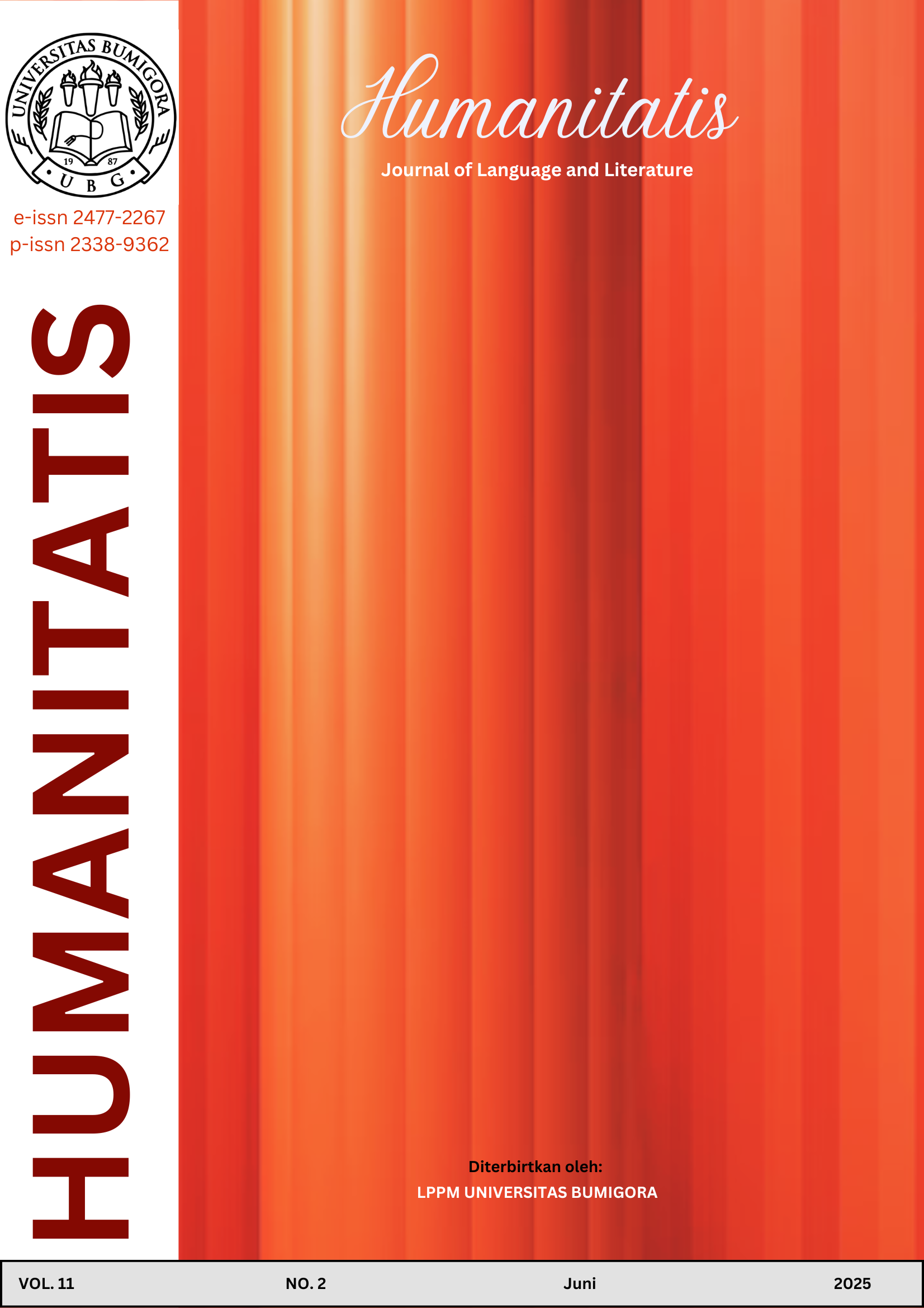Shining Through the Hierarchy: Rachel Kim’s Psychological Journey in Shine by Jessica Jung Through Maslow’s Lens
DOI:
https://doi.org/10.30812/humanitatis.v11i2.4517Keywords:
Character Analysis, K-pop Industry, Maslow’s Hierarchy of Needs, Psychological Development, Self-Actualization, ShineAbstract
This study explores Rachel Kim’s psychological development in Shine by Jessica Jung through the lens of Maslow’s Hierarchy of Needs. Rachel’s journey as a K-pop trainee illustrates the progression through Maslow’s five levels—physiological, safety, love and belongingness, esteem, and self-actualization. The novel highlights how Rachel and her family struggle with financial stability, addressing her psychological and safety needs. As she navigates friendships, family expectations, and industry challenges, Rachel’s love and belongingness needs come into focus. Her self-esteem is tested by public scrutiny and personal setbacks, but is ultimately restored through support from loved ones. The culmination of her journey is self-actualization, as she embraces her talent and achieves her dream of debuting as a K-pop idol. Through Rachel’s character arc, Shine reflects the universal nature of human motivation, demonstrating how ambition, resilience, and emotional fulfillment shape an individual’s growth. This analysis provides a deeper understanding of the novel’s themes, emphasizing the interplay between personal aspirations and psychological development in high-pressure environments.
References
Ahmadi, A. (2023). A spiritual journey of an Indonesian woman: The evidence through literature from a psychospiritual perspective. Cogent Arts and Humanities, 10(2). https://doi.org/10.1080/23311983.2023.2270789
Andini, M. (2017, May). Hierarchy of human needs through the main character in Hitch film [Bachelor Thesis]. Fakultas Adab dan Humaniora.
Cahyani, F. D. (2021). Hierarchy of Human Needs as Reflected in The Main Character of Melissa De La Cruz’s Something in Between: A Psychological Approach [Bachelor Thesis]. Universitas Ahmad Dalan.
Durou, G. (2020). Class is What Capitalism Makes of It: Challenging the Lure of “Realism” in Mainstream Class Analysis. Critical Sociology, 46(2), 207–223. https://doi.org/10.1177/0896920519830752
Hoffmann, J. D., Ivcevic, Z., & Maliakkal, N. (2021). Emotions, Creativity, and the Arts: Evaluating a Course for Children. Empirical Studies of the Arts, 39(2), 123–148. https://doi.org/10.1177/0276237420907864
Hutagaol, F. Y. N., & Widyaningrum, A. (2023). Maslow’s and Freud’s Theories Reflected in Andrew Laeddis’ Character. Humanitatis: Journal of Language and Literature, 10(1), 109–122. https://doi.org/10.30812/humanitatis.v10i1.2971
Jung, J. (2020). Shine. Simon & Schuster Books for Young.
Krippendorff, K. (2018). Content Analysis: An Introduction to Its Methodology (4th ed.). Sage Publication Ltd.
Lee, J. J., Lee, R. K. Y., & Park, J. (2020). Unpacking K-pop in America: The Subversive Potential of Male K-pop Idols’ Soft Masculinity. International Journal of Communication, 14, 5900–5919.
Lubis, N., & Satria, R. (2021). Hierarchy of Needs in Angie Thomas’s Novel "The Hate U Give": Abraham Maslow. Humanitatis: Journal of Language and Literature, 8(1), 53–60. https://doi.org/10.30812/humanitatis.v8i1.1342
Maslow, A. H. (1943). A Theory of Human Motivation. American Psychological Association.
Maslow, A. H. (1970). Motivation and Personality. Collins.
Naeem, M., Ozuem, W., Howell, K., & Ranfagni, S. (2023). A Step-by-Step Process of Thematic Analysis to Develop a Conceptual Model in Qualitative Research. International Journal of Qualitative Methods, 22, 1–18. https://doi.org/10.1177/16094069231205789
Nur, S., Utami, R., Wajiran, W., & Arain, F. (2024). Striving for Superiority Reflected in the Main Character of Angie Thomas’s The Hate U Give: A Psychological Study. JOLLS: Journal of Language and Literature Studies, 4(4), 921–934. https://doi.org/10.36312/jolls.v4i4.2257
Padua, M. M. O. (2010). Emotion: Woman’s strength or frailty? Kemanusiaan, 17, 1–17.
Pamungkiasari, F., & Wajiran, W. (2024). Inequality Experienced by Women as Reflected in Louisa May Alcott’s Little Women. LEKSEMA: Jurnal Bahasa dan Sastra, 9(2), 107–118.
Shahnaz, R. (2023). The Relationship Between Literature and Psychology: An Overview. Dareecha-e-Tahqeeq, 4(3), 36–41. https://doi.org/10.58760/dareechaetahqeeq.v4i3.134
van der Zalm, A. J., Barroso, J., Browne, P., Casey, W., Gordon, J., Henry, T. R., Kleinstreuer, N. C., Lowit, A. B., Perron, M., & Clippinger, A. J. (2022). A framework for establishing scientific confidence in new approach methodologies. Archives of Toxicology, 96(11), 2865–2879. https://doi.org/10.1007/s00204-022-03365-4
Wahyuni, P. S., Ihsan, P., & Lestari, S. H. (2022). Unhomeliness and Hybridity in Jung’s Shine: Postcolonial Study. Ideas: Journal on English Language and Learning, Linguistics and Literature, 10(1), 632–647. https://doi.org/10.24256/ideas.v10i1.2739
Wajiran, W. (2013). The Domination of Ideas and Intellectuality in Gaining the Power and Hegemony in Man and Superman by George Bernard Shaw. Jurnal Humaniora UGM, 25(2), 143–150. https://doi.org/10.22146/jh.2357
Wajiran, W. (2024). Metode Penelitian Sastra: Sebuah Pengantar (1st ed., Vol. 1). Uwais Inspirasi Indonesia.
Yuningsih, G. C. (2019). Figurative Language Used in Jessica Jung’s First Mini Album [Bachelor Thesis]. Universitas Muhammadiyah Surakarta.
Yunita, W. N. (2017). Hierarchy of Human Needs of Amir in Khaled Hosseini’s The Kite Runner [Bachelor Thesis]. Universitas Islam Negeri Maulana Malik Ibrahim Malang.
Downloads
Published
Issue
Section
License
Copyright (c) 2025 Anita Beli Sawintri, Wajiran Wajiran

This work is licensed under a Creative Commons Attribution 4.0 International License.
















